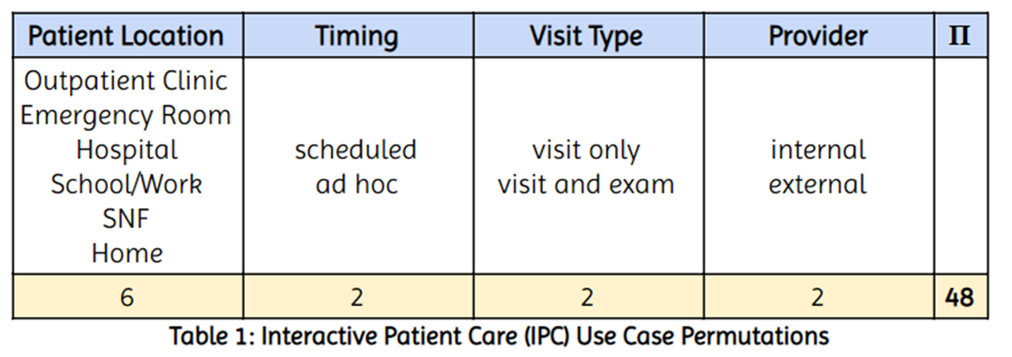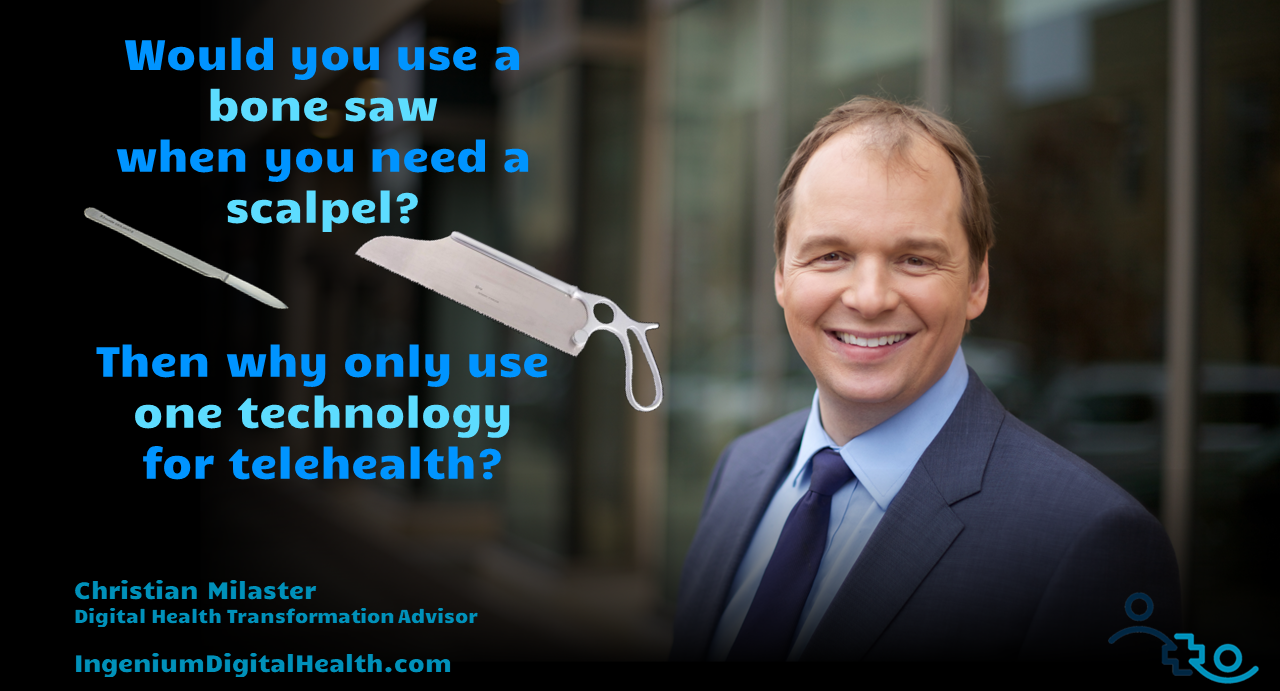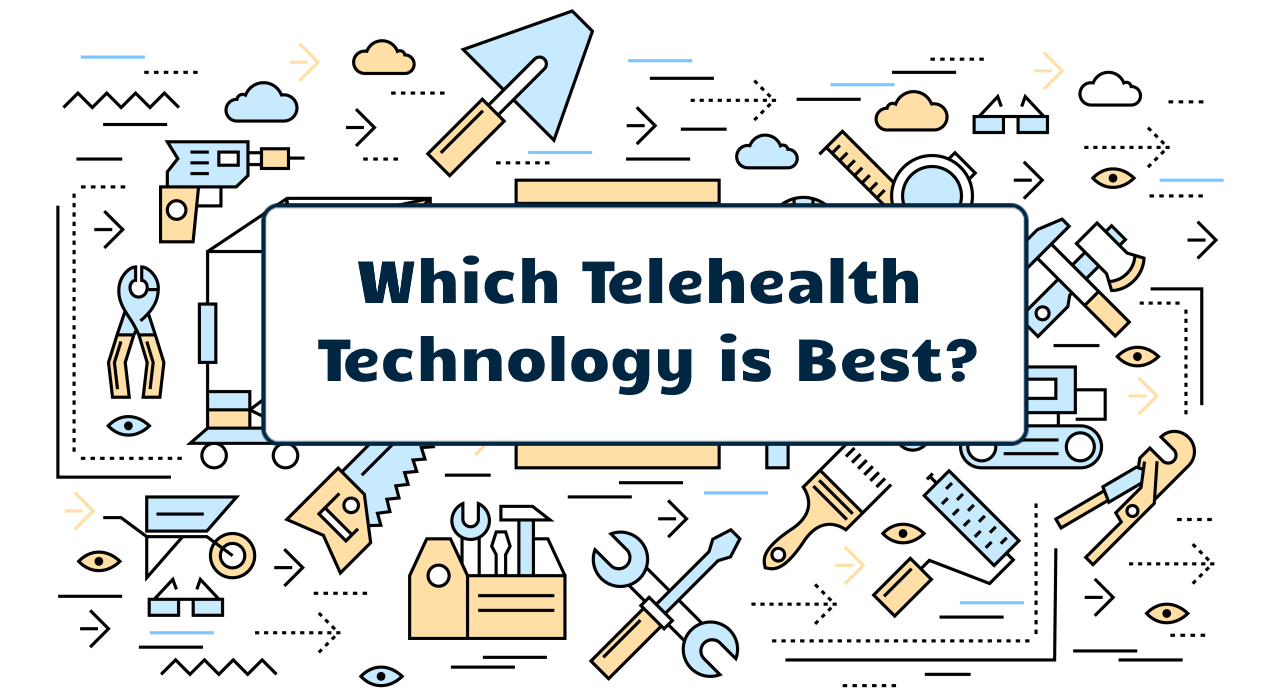As healthcare organizations are assessing how to best leverage telehealth for the delivery of care in the long run, the question turns quickly to assessing the various technology solutions that an organization may find itself using.
From simple video chat solutions such as Zoom or teams to more telehealth-designated software solutions such as Doxy.me, VSee, or Mend; or hardware solutions such as carts from Avizia (now Amwell), Intouch (now Teladoc), or AMD: Many organizations have amassed a plethora of different telehealth technologies and the question arises: Which technology is the best to use for telehealth? Shouldn’t we limit ourselves to just one telehealth technology or at least one vendor?
So, which technology is best?
That question can best be answered along the lines of my most favorite of advisors — the Cheshire cat: “Well, that depends a great deal on where you want to get to.”
Yes, it truly does “depend”, since there are literally hundreds of different telehealth services that are requiring a dozen or more different technology solutions.
But before I go there, let us explore where the desire for a single (or limited number of) telehealth technology solution(s) comes from.
History of Single Technology/Vendor Strategies
To understand where most healthcare IT leaders are coming from we need to go back 20, 30 years when healthcare IT was not as well managed and not as well staffed as it is today. In those days, with the onslaught of new technologies, in larger health systems oftentimes different solutions were acquired by different departments that in essence were doing pretty much the same thing.
As health systems over time consolidated technical support in a single IT team, any technology support requests ended up with IT, which now found itself supporting multiple applications doing the same thing and having to maintain different licenses, contracts and communication channels with the various vendors.
In addition, most applications do not exist in isolation – they consume data from other applications and create data that is used or stored by yet another set of applications. With multiple applications doing similar things, all of those interfaces and integrations had to be configured and maintained, which became a costly endeavor.
Those days were for most IT departments the birthplace of a Technology Standard that sets forth which vendors and solutions anyone in the organization should be using, so as to keep licensing fees and technical support cost effective.
So let’s explore whether and how telehealth may be different.
The wide, vast world of Telehealth Services
At Ingenium, we define Telehealth as “Delivering Care at a Distance” and under that definition there are a number of different clinical telehealth services:
- Patient Portals – the ability for patients to self-schedule appointments, securely exchange messages with the care team or access clinical notes, lab results or immunization records
- TeleEducation – the ability to view, for example, information about pre-surgical or post-surgical care or post-diagnostic information.
- Store & Forward Telemedicine – sending images, radiology reports or other information for asynchronous review and interpretation.
- Remote Physiological Monitoring – the continuous and periodic collection and transmission of vital signs for the purpose of chronic disease management or post-discharge care.
- Interactive Patient Care – the live, synchronous communication with patients (a.k.a., virtual care), typically over an audio/video connection (though a lot of it is done telephonically these days) either without or with remote examination.
Obviously each of these different services requires a different type of technology solution. But even within each service category, for example “Interactive Patient Care” there are numerous different variations of “interactive patient care” as the following chart illustrates:



Interactive Patient Care can be delivered to a variety of different locations, can be pre-scheduled or ad hoc, can include an examination and use internal or external providers. When you combine the different options across those four characteristics, there are 48 different combinations.
Let’s take a look at a few of those combinations and what technology solution would be needed.
TeleStroke: For a patient in the Emergency Room that has an ad hoc need for an evaluation and exam by an external neurologist due to suspected stroke, the technology solution (often a cart with remote-controlled pan-tilt-zoom HD camera to allow the neurologist to zoom in on the patient’s facial feature and expressions) is most likely imposed by the TeleStroke service that has been contracted to provider 24×7 coverage of the ER.
TeleUrgentCare: For a patient, typically at home or at work, who would like an ad hoc evaluation of an urgent condition (such as a UTI) with an on-call provider (who is most often contracted by the health system), the solution is most likely a SmartPhone app or a web interface on the patient end that includes an intake questionnaire and an on-call queue management system with a video-chat-only option on the provider end.
TeleBehavioralHealth: For an established patient for a regular, scheduled follow-up visit with their internal counsellor at home, an easy solution is most often a link to a video chat room that works on a SmartPhone or in a web browser. Another common solution would be the EMR’s video solution that is often accessed through the patient portal.
From these three examples you can easily extrapolate that there is definitely the need for more than one telehealth technology. While there is probably not the need for 48 different technologies, depending on how many interactive patient care services the organization implements, it may however be justifiable to use a dozen or so different solutions that are optimized for their specific use case.
I often use the comparison to the vast suite of surgical tools that is used in today’s modern surgical theatres: you typically see a wide range of scissors, clamps, scalpels and forceps, each serving its own unique purpose (in the early 1900s the Mayo brothers of Mayo Clinic fame contracted with a local machine shop to manufacture unique one-of-a-kind specialized surgical instruments for their ever growing list of surgeries. Nobody would suggest that a limited set of tools should suffice, and the same applies to the variety of uses for telehealth.



Finding the Best Telehealth Technology
So how do you find the best telehealth technology? That actually depends, obviously, in great part on what you need the solution to do for you.
The best starting point here is to first systematically define the requirements which, for telehealth services, starts with the the development of the following:
- a strategic case (why should we do it),
- a business case (is it financially feasible),
- a clinical case (is it medically sound)
- the workflow (what needs to happen)
The combination of these four explorations define the new telehealth service and will identify a list of requirements to guide the identification and selection of the telehealth technology that will fit the needs. And if the solutions in the marketplace do not meet your needs, you can now make conscious changes to your workflow.
Too many have made the mistake of first searching for a vendor, a solution and then trying to make that solution fit a vaguely defined workflow and requirements and that oftentimes leads to many false starts and a lot of frustration.
So, which Telehealth Technology is best? It is the technology that best satisfies your strategic, financial, clinical and workflow needs. That is the Telehealth Technology you want.
In one of the upcoming articles I will also cover IT manager’s favorite topic of “integration” and what other factors to keep in mind when selecting a telehealth vendor.
How many telehealth technologies do you have in use? Are they meeting all your needs? Let me know…








To receive articles like these in your Inbox every week, you can subscribe to Christian’s Telehealth Tuesday Newsletter.
Christian Milaster and his team optimize Telehealth Services for health systems and physician practices. Christian is the Founder and President of Ingenium Digital Health Advisors where he and his expert consortium partner with healthcare leaders to enable the delivery of extraordinary care.
Contact Christian by phone or text at 657-464-3648, via email, or video chat.







Leave A Comment